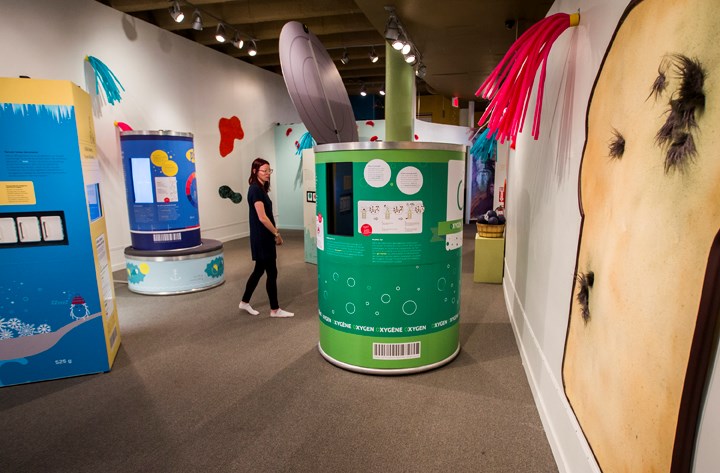For a museum exhibit called A Taste of Science, there’s surprisingly little to eat. I was hoping for samples of cheese and wine, but alas, this is not that kind of show.
It is, however, a really fun and informative look inside the science behind food and food preservation. Have you ever thought about the importance of canning? Can you imagine what people ever did before the invention of the refrigerator or the sandwich bag? Did you ever smell something that’s gone bad in your kitchen and wonder, ‘Ugh, what is that?’
If you’re in a pickle about any of these questions, then have no fear. The travelling exhibit is now on at the Musée Héritage Museum and you are invited, as the promotional materials say, to “come and experience the fun in fungi.” The show is highly reminiscent of what you’d expect at the Telus World of Science. Here though, it’s not the typical kind of display though it still fits the bill for the institution’s core cultural objectives.
“We like to have a variety of exhibitions all the time, and we hadn’t had a specifically family-oriented one for a while. We thought this would be really fun,” said Joanne White, the museum’s curator. “Also, part of our mandate is our natural environment as well as our historical stories, so we like to bring in some science things and explore different subjects in the gallery.”
She explained that “higher tech shows” like this aren’t the sort of thing that is always possible in a relatively small museum like this one.
If you’re like me and enjoy endlessly watching fruits, vegetables and other foods as they slowly decompose over days, then this is the exhibit for you. Thankfully, exhibit creators at the Canada Agriculture and Food Museum in Ottawa have put together an endlessly-looping video of time lapse photography. Watch the fuzz slowly take over a bunch of grapes, shrivelling them up like alien raisins in the process. How come there isn’t a TV channel with this on 24 hours a day?
“This one definitely has some gross-out factor, but that’s really fun too, and it’s only a little bit,” White continued.
As you wander around surrounded by giant food containers and Styrofoam displays of giant blueberries gone bad, there are activities to help you learn about fungi, germs, microbes, fermentation and what makes food spoil. If you don’t mind catching a whiff of something unpleasant, there are four little doors that will give you a puff of different things that have clearly expired in the fridge. Pee-ew!
If you’re not that brave, maybe stick with the non-interactive elements and you’ll certainly still pick up the important points about why pasteurization is so important. You might even learn that a ferment is a group of beneficial microorganisms that work together in a complementary manner.
White learned a few things herself like how to make mouldy things.
“When you start to think about it, different things mould in different ways because there are different types of mould. There’s white moulds, and black moulds, and green moulds … if you look around your house, hopefully not too often, you’ll be able to notice the differences in the processes.”
I learned that some bacteria are friends. Take lactic bacteria, for example. It changes the sugar in milk (lactose) into lactic acid, which is what kills bad microbes so that you can eat and enjoy that delicious, nutritious yogurt. You should make sure that yogurt gets back into the fridge when you’re done with it, though. Enzymes and microbes are generally active between 4 and 60C. Oh.
So that’s why fridges are at their optimal temperatures between 0 and 4C. It also makes sense why boiling and cooking at high temperatures is a way of killing bad things in your food. At 65C, the heat destroys molecules that support life by damaging the enzymes and killing many microbes. At even hotter temperatures you can wipe out all microbes, in a process that is called sterilization.
This stuff is fascinating and fun, but watching those time lapse videos of food spoiling is still the best, even if it does put me off of poutine. That stuff gets pretty nasty if you leave it out for too long. Better eat it hot when the gravy is still steaming.
Ah, who am I kidding? Nothing will put me off of poutine.
Science can be magical
To add to the excitement of learning about food, the museum is going to host local high school science teacher Michael Ng to put on a few demonstrations when Family Day rolls around.“We’re going to explode some stuff,” he explained, not missing a beat with his sensational early previews.
He will be putting on a show in the atrium from 2 to 3 p.m. during the Fun with Science event that runs from noon to 4 p.m. on Mon., Feb. 19.
Ng has one demo that will focus on the iron content of a breakfast cereal not commercially available in Canada.
“We can show when we dissolve it in water that we can put a magnet and see if we can extract actual iron. We’ve tried science experiments testing different types of cereal with the kids and it just doesn’t extract the iron so you can really see it in a soup-base cereal. Every time we try Total, it just works.”
He might also bring his Coke and Mentos along, so bring your rain slicker if you intend to be front row. He’ll offer an explanation of why the two combined make for some always memorable gushers. He said that he has a few other food science tricks up his sleeve too, one of which is called a paper stomp rocket.
“I’m not allowed to do any flammable stuff inside city hall. It’s just powered by the air in a 2-litre pop bottle. It goes amazingly high. It goes all the way to the roof in that atrium.”




